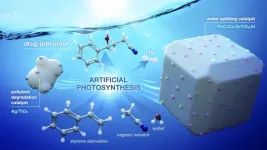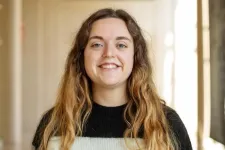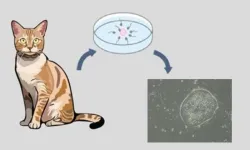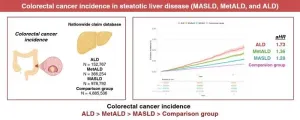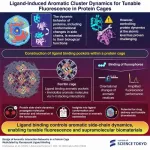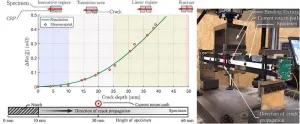(Press-News.org) A research team led by Assistant Professor Shogo Mori and Professor Susumu Saito at Nagoya University has developed a groundbreaking method of artificial photosynthesis that uses sunlight and water to produce energy and valuable organic compounds, including pharmaceutical materials, from waste organic compounds. This achievement represents a significant step toward sustainable energy and chemical production. The findings were published in Nature Communications.
“Artificial photosynthesis involves chemical reactions that mimic the way plants convert sunlight, water, and carbon dioxide into energy-rich glucose,” Saito explained. “Waste products, which are often produced by other processes, were not formed; instead, only energy and useful chemicals were created.”
Their technique, which they called artificial photosynthesis directed toward organic synthesis (APOS), meets all the criteria of artificial photosynthesis. It represents a paradigm shift in the field of artificial photosynthesis due to its use of organic matter and water as raw materials in the reaction.
“The key to APOS’s success is the cooperative effects of two types of inorganic semiconductor photocatalysts,” Saito said. “The catalysts, respectively, promote the decomposition of the waste organic matter and water through water splitting, leading this time to the synthesis of useful organic compounds and ‘green’ hydrogen.”
The researchers describe an array of practical applications for their discovery. In the experiment, they utilized different organic raw materials to synthesize more than 25 distinct alcohol and ether products containing a wide range of functional groups, including an analog of an antidepressant and a hay fever drug. The technique also allows the modification of organic materials, which they showed by modifying a drug used for treating elevated lipid levels in the blood.
“Our state-of-the-art technique could potentially produce useful carbon materials without forming carbon dioxide and waste,” Saito said. “An example is acetonitrile that we used in this experiment as a starting material. Acetonitrile is a byproduct generated during the industrial mass production of polymer and carbon nanofibers. Using it in APOS enabled it to become a useful product, potentially reducing waste.”
This research marks the beginning of a new field of artificial photosynthesis for organic synthesis, and the results are expected to contribute to sustainable medical and agricultural chemical production that utilizes renewable energy and resources such as sunlight and water.
END
Turning waste organic compound into useful pharmaceuticals and energy using a technique inspired by photosynthesis
2025-02-27
ELSE PRESS RELEASES FROM THIS DATE:
Violence alters human genes for generations, researchers discover
2025-02-27
In 1982, the Syrian government besieged the city of Hama, killing tens of thousands of its own citizens in sectarian violence. Four decades later, rebels used the memory of the massacre to help inspire the toppling of the Assad family that had overseen the operation.
But there is another lasting effect of the attack, hidden deep in the genes of Syrian families. The grandchildren of women who were pregnant during the siege — grandchildren who never experienced such violence themselves — nonetheless bear marks of it in their genomes. ...
Scientists discover key protein in resilience to stress
2025-02-27
When faced with chronic stress, why do some people develop anxiety and depressive symptoms while others show resilience? A protein that acts as a cannabinoid receptor and is present in the structure controlling exchanges between the bloodstream and the brain could be part of the answer, according to a study published today in Nature Neuroscience.
“The protein, called cannabinoid receptor type 1 (CB1), is part of the blood-brain barrier, the dynamic structure that protects the brain by regulating the passage of molecules between the bloodstream and ...
Nasal spray shows preclinical promise for treating traumatic brain injury
2025-02-27
A new study led by researchers at Mass General Brigham suggests a nasal spray developed to target neuroinflammation could one day be an effective treatment for traumatic brain injury (TBI). By studying the effects of the nasal anti-CD3 in a mouse model of TBI, researchers found the spray could reduce damage to the central nervous system and behavioral deficits, suggesting a potential therapeutic approach for TBI and other acute forms of brain injury. The results are published in Nature Neuroscience.
“Traumatic brain injury is a leading cause of death and disability — including cognitive decline ...
Cambridge initiative to address risks of future engineered pandemics
2025-02-27
Covid-19 showed us how vulnerable the world is to pandemics – but what if the next pandemic were somehow engineered? How would the world respond – and could we stop it happening in the first place?
These are some of the questions being addressed by a new initiative launched today at the University of Cambridge, which seeks to address the urgent challenge of managing the risks of future engineered pandemics.
The Engineered Pandemics Risk Management Programme aims to understand the social and biological factors that might drive an engineered pandemic and to make a major contribution ...
Unmasking inequalities in AI: new research reveals how artificial intelligence might reinforce inequality
2025-02-27
The researchers challenge the widespread belief that AI-induced bias is a technical flaw, arguing instead AI is deeply influenced by societal power dynamics. It learns from historical data shaped by human biases ,absorbing and perpetuating discrimination in the process. This means that, rather than creating inequality, AI reproduces and reinforces it.
“Our study highlights real-world examples where AI has reinforced existing biases.” Prof. Bircan says. “One striking case is Amazon’s AI-driven hiring tool, which was found to favor male candidates, ultimately reinforcing gender disparities in the job market. Similarly, government AI fraud detection ...
Taking sports science in her stride: How Dr. Nerea Casal García aims to maximize performance on the track
2025-02-27
The following is a Q&A with Dr Nerea Casal García, a sports scientist focusing on sports training and performance optimization. To speak to the author, or to receive an advance copy of the paper, please write to: press@frontiersin.org The paper will be published on 27 Feb 2025 06:15 CET]
Dr Nerea Casal García is an athlete, personal coach, and injury readaptation specialist who last year completed a PhD on observational analysis in elite sports. Today, she is a professor at the Institut Nacional ...
Pioneering work generates feline embryonic stem cells in boon for cats
2025-02-27
As different as they may seem, humans and cats have similar ailments, but in terms of health care, veterinary regenerative medicine is not as advanced.
A possible solution rests in embryonic stem cells, which can differentiate into various types of cells and be transplanted to restore internal damage. Further, they are characterized by their near-natural state similar to induced pluripotent stem (iPS) cells. Recent research has successfully generated feline iPS cells, but not embryonic stem cells, so research on these cell lines is essential to improve the quality ...
Decoding the link between colorectal cancer risk and steatotic liver disease
2025-02-27
Alcoholic and non-alcoholic fatty liver disease (NAFLD) are well-known risk factors for colorectal cancer (CRC). NAFLD has emerged as a heterogenous disease tightly linked to metabolic dysfunction and has been redefined under the umbrella term ‘steatotic liver disease’ (SLD). However, CRC risk variations across different SLD subgroups remain unknown. Now, researchers from Japan have discovered that the risk of CRC varies significantly among SLD subgroups, with patients with alcoholic liver disease being at higher risk.
Lifestyle-related disorders have become increasingly prevalent, representing a major health ...
Controlling conformational changes in protein aromatic side chains
2025-02-27
Novel protein cage system can control and visualize orientational changes in aromatic side chains upon ligand binding, as reported by researchers at Institute of Science Tokyo. By inducing coordinated molecular changes, this approach enables precise control over protein dynamics while also enhancing fluorescence properties. Their breakthrough could lead to applications in biomolecular robotics, drug delivery, and advancing the development of responsive biomaterials.
The dynamic nature of proteins—their ability to bend, fold, and change shape in response to their environment—underlies ...
Experimental and numerical analysis of the potential drop method for defects caused by dynamic loads
2025-02-27
In our paper “Experimental and Numerical Analysis of the Potential Drop Method for Defects Caused by Dynamic Loads”, we investigate how the electrodynamic proximity effect can be utilized to enhance the defect sensitivity of PDM in SHM applications by proper arrangement of the measurement setup. We showed how eddy current effects present in our PDM setup can be modeled analytically and numerically. Lock-in technique and the application of the skin effect allow high- resolution impedance ...
